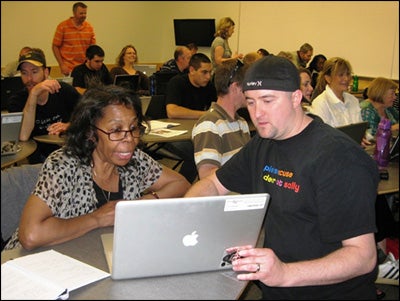Teachers learn video game design at institute promoting STEM education
Returning participant Sean Boyer helps new teacher Janie Perry learn computational thinking through the AgentSheets software and Scalable Game Design curriculum at the Scalable Game Design Summer Institute at CU-Boulder.
More than 60 middle- and high-school teachers from around the country are learning to design video games at the University of Colorado Boulder as part of the third annual Scalable Game Design Summer Institute, May 31 to June 10.
The institute is part of CU-Boulder's iDREAMS project, which is funded by the National Science Foundation to teach computational thinking skills through video game design.
The project team includes researchers from CU-Boulder's computer science department, School of Education, software partner AgentSheets Inc., and the Science Discovery and Upward Bound outreach programs. More than 15 community college students also are participating in the institute to assist the teachers.
The iDREAMS project, now in its third and final year, was projected to reach 1,200 students through their teachers, but is now on track to involve more than 5,000 students.
Teachers have come to the institute from diverse school districts in Colorado, Wyoming, Texas, Georgia, Mississippi, Ohio, South Dakota and Alaska with a common interest in inspiring middle school students to pursue college degrees and careers in science, technology, engineering and math (STEM) subjects, using a motivating curriculum that begins with video game design and progresses to the programming of scientific simulations.
Before the teachers can inspire their students, they must first master the art of video game design, in an environment that will give them the tools and support they need to take the curriculum into their classrooms.
The institute uses the Scalable Game Design curriculum developed at CU-Boulder and the award-winning AgentSheets game- and simulation-authoring software as the tools for building basic competencies in computation and problem-solving, which students may apply in a range of technological and STEM careers.
These tools are allowing teachers to use creative, constructive programming activities to engage students and improve student learning. For example, after students at Fort Lupton Middle School made their own Frogger-like video game, they used AgentSheets software to create simulations of virus outbreaks and forest fires to learn data analysis and statistics.
Research results have been impressive, showing overwhelming positive response and a desire on the part of the students to take more STEM classes, according to project director Alexander Repenning of the Computer Science department, and co-directors David Webb of the School of Education and Andri Ioannidou of AgentSheets Inc. Results so far have shown that about 70 percent of middle school students participating in Scalable Game Design classes wish to continue with more classes.
About 45 percent of the students participating in the iDREAMS project are girls, and 56 percent are underrepresented minorities. School districts involved range from affluent, technology-rich districts to urban, rural and Native American reservation schools. The project is able to reach students at an age when girls and underrepresented minorities often turn away from challenging subjects.
"While The Washington Post laments that the United States education system is merely producing a nation of electronic consumers, these teachers and school districts are taking a bold step forward to bring computer science education back to middle schools to create a new generation of technological innovators," Repenning said. "This video game design curriculum is designed to teach computational thinking...the modeling, problem-solving and programming skills necessary for success in STEM subject areas."
For more information, visit http://scalablegamedesign.cs.colorado.edu and http://www.agentsheets.com.


